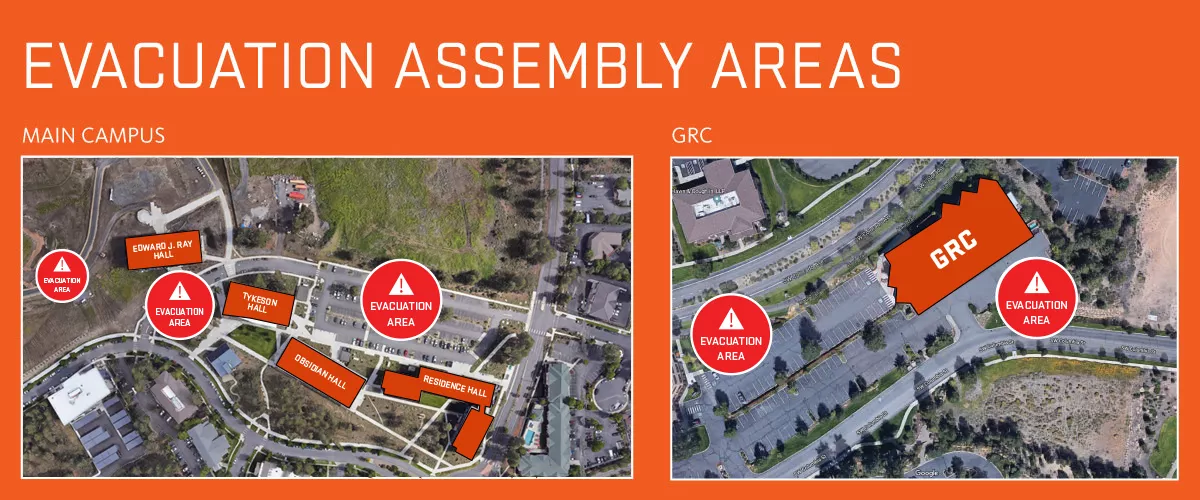Image

In the event of an evacuation, designated assembly areas on campus are the Chandler Parking Lot, Bruckner Courtyard, and the Oval Green.
For the Graduate Research Center, designated evacuation areas include the main parking lot located in front of the building entrance and the lower parking lot.
All individuals must proceed calmly to the nearest designated evacuation area and remain there until an “all clear” notification is issued by emergency personnel. Individuals should move away from buildings and other structures to ensure safety while awaiting further instructions.
Response
When you receive notice to evacuate a building, or when evacuating due to a potentially dangerous situation:
- Immediately comply with alarms and orders to evacuate.
- Classes in session must evacuate
- All OSU-Cascades employees share the responsibility to ensure students visitors, visiting vendors and guests are evacuated.
- If time allows and without endangering yourself,
- Place equipment in a safe configuration
- Close doors and windows
- Inform others in your vicinity of the current situation
- Take any personal items you may need
- Leave the building - do not use elevators.
- Use the nearest, safest exit
- Warn others as you evacuate, but do not delay your own evacuation
- All personnel are to exit the building
- Assist persons with mobility concerns
- Offer to assist blind or low-vision persons through hallways and down stairways
- For those who are deaf or hard-of-hearing, if the building does not have strobe alarms, gain their attention, and write a note informing them about the evacuation in progress.
- Wheelchair users should follow evacuation routes on the ground floor of a building. If not on the ground floor, proceed to the nearest stairway area. Rescue personnel will search these areas first and help individuals with disabilities evacuate the building.
- If the stairway area is not accessible, go to an area that provides a barrier between you and the hazard
- Notify others who are evacuating to inform responders of your location
- Dial 9-1-1
- Place a cloth or clothing out a window to attract attention
- Take your cell phone, valuables, and evacuation kit with you.
- Proceed outside the building to the evacuation assembly area. All personnel should move as far away from the building as practical, so as not to be in danger or in the way of emergency responders (minimum fifty feet away).
- If the evacuation assembly area is not suitable, move to another area
- In the event of an earthquake, the evacuation assembly area may be too close to buildings or other objects that could fall. Move to the nearest open space/field to assemble.
- Conduct accountability for personnel under your supervision.
- Wait for official notice before attempting to re-enter the building.
Classroom / Lab Instructors
- Identify an assembly point fifty feet from the building.
- Direct the class to exit through the nearest and safety exit.
- Assign two individuals for each student with disabilities to assist in their safe evacuation form the building.
- Check the classroom/lab area to ensure evacuation is complete prior to exiting the area.
- Once outside, check to see that no one is missing.
Recovery
- Check in with your leadership to determine response status
- Do not enter a building until allowed to do so
- Once entering the building, inspect you work area and report any issues
Preparedness
- Identify the two closest evacuation points
- Identify the evacuation assembly points
- Identify the locations for fire alarm pull stations
- Identify the locations for emergency equipment (AED/fire extinguisher)
- Pre-identify personnel who may have existing conditions that necessitate assistance during an emergency or evacuation.
- Report to Campus Safety any obstructions to the evacuation routes or fire doors